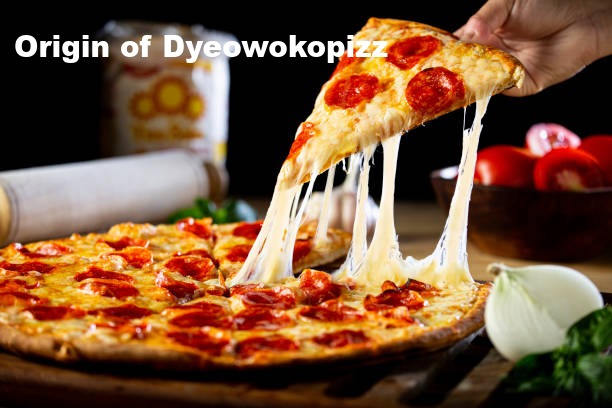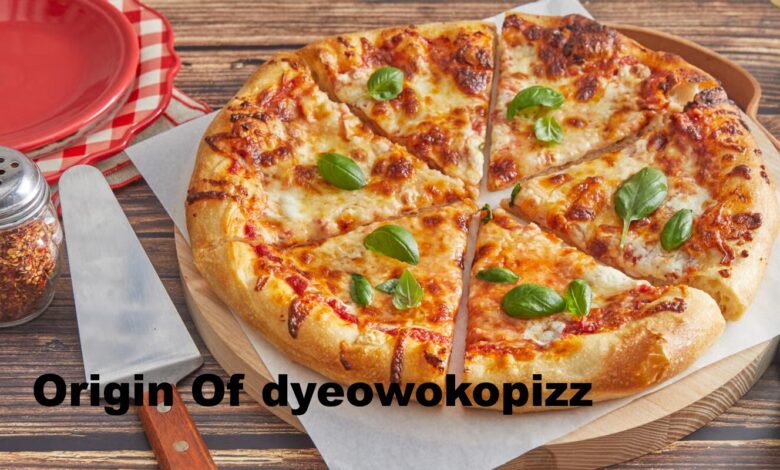The Origin of Dyeowokopizz: A Fascinating Blend of Culture, Creativity, and Culinary Mystery

Origin of Dyeowokopizz The word Dyeowokopizz might sound unfamiliar at first — almost like a word born from another dimension of food innovation. But dig a little deeper, and you’ll realize that this term has an intriguing story to tell. It’s not just about taste or culinary trends; it’s about how language, culture, and creativity intertwine to give birth to something entirely unique. Whether you’re a food lover, a linguist, or just someone curious about how such a term came to exist, understanding the origin of Dyeowokopizz opens a window into a broader world of fusion and imagination.
A Name that Sounds Like a Story: The Linguistic Birth of Origin of Dyeowokopizz
The name Origin of Dyeowokopizz doesn’t sound accidental. In fact, it feels like a carefully crafted word, fusing together several recognizable elements. When broken down, it seems to borrow fragments from “Dyeo,” “woko,” and “pizz” — each representing a piece of cultural and culinary identity. Linguistically, this is what experts call a portmanteau, where different words or syllables merge to create something new yet familiar.
Origin of Dyeowokopizz could be interpreted as a creative nod to “dough,” emphasizing the foundation of many world-famous dishes like bread, pasta, and of course, pizza. “Woko,” on the other hand, clearly evokes the Asian wok, the iconic pan used for high-heat stir-frying. Finally, “pizz” hints at the unmistakable influence of pizza — one of the world’s most beloved comfort foods. Combine them, and you get Origin of Dyeowokopizz a symbolic fusion of dough, wok, and pizza — a global culinary mashup in one catchy term.
Interestingly, linguistic historians often highlight how modern fusion cuisine doesn’t just merge cooking styles — it merges languages. Think of names like “Tex-Mex,” “Japadog,” or “Cronut.” Each one tells a story through its syllables, and Origin of Dyeowokopizz follows the same pattern. It’s more than a name — it’s a micro-narrative of globalization, where cultures meet not in a textbook, but on a plate.
Tracing Its Cultural Roots: Where East Meets West in the Kitchen

While the precise birthplace of Origin of Dyeowokopizz remains a subject of playful debate, the concept clearly draws from the meeting point of Asian and Western cuisines. The “wok” symbolizes the East — quick, fiery, and rich in aromatic sauces — while “pizz” brings the spirit of Italy’s slow-baked, flavor-layered tradition. The fusion of these two philosophies could only emerge in an age when chefs, travelers, and creators began to blur the boundaries of traditional cuisine.
Some suggest that Origin of Dyeowokopizz may have originated as a street-food experiment, where a chef decided to cook pizza dough in a wok, adding stir-fried toppings instead of the usual baked cheese and tomato sauce. Others believe it was born in a cross-cultural restaurant kitchen — perhaps a place where chefs from different culinary schools collaborated and accidentally stumbled upon a dish that was too bold to ignore.
What makes the origin fascinating is not the “where” but the “why.” The early 21st century marked an explosion in fusion cuisine trends, with people seeking bold new combinations of taste and texture. Social media food culture also amplified this experimentation. Videos of sizzling, unconventional food hybrids became viral sensations overnight. So, even if the name Origin of Dyeowokopizz started as a local invention, it fit perfectly into a global appetite for novelty.
In many ways, Origin of Dyeowokopizz represents more than a dish — it symbolizes the world’s evolving culinary identity, where creativity replaces convention and where tradition is not abandoned but reimagined.
The Creative Spark: How Innovation Shaped the Concept of Origin of Dyeowokopizz
To understand Origin of Dyeowokopizz properly, we have to look at the creative process behind it. In modern culinary innovation, chefs often combine different textures, techniques, and cultural cues to surprise the palate. Dyeowokopizz sits right at the center of that artistic space — a fusion of art and appetite.
Imagine a chef experimenting late at night: the wok sizzling, the aroma of garlic and dough filling the air. What if pizza toppings were stir-fried first, instead of baked? What if the crust wasn’t flat, but pan-seared? That’s the kind of thinking that gives rise to something like Origin of Dyeowokopizz. It’s not born from necessity, but from curiosity — the creative urge to take familiar ingredients and make them dance to a new rhythm.
Culinary experts often refer to this as “boundary-breaking cuisine.” Just like music evolves by blending genres, food evolves when boundaries blur. When East meets West in the kitchen, the result can be unexpected yet delightful. Origin of Dyeowokopizz embodies this modern culinary movement — not just as a product, but as an idea. It’s proof that when creativity and culture collide, something magical happens on the plate.
A Symbol of Global Fusion: Beyond Food and Into Philosophy
The beauty of Origin of Dyeowokopizz lies not only in its potential as a food item but also in what it represents philosophically. It’s an emblem of global unity — a reminder that innovation often happens when people embrace diversity instead of fearing it. Just like the dish itself fuses ingredients from different parts of the world, the concept speaks to a broader human experience: we’re all products of mixing, adaptation, and shared evolution.
Think about it: centuries ago, the tomato wasn’t native to Italy, and chili wasn’t native to Asia. Yet, these ingredients crossed oceans, reshaped entire cuisines, and became cultural staples. Origin of Dyeowokopizz is just another chapter in that long story of exchange. It mirrors the modern world — fast-paced, interconnected, and beautifully hybrid.
In many ways, Origin of Dyeowokopizz also challenges traditional culinary hierarchies. It says that food doesn’t have to belong to a specific culture to be valid or authentic. Instead, authenticity lies in intent and creativity. The dish becomes a metaphor for how humans continue to evolve — always combining, always experimenting, always creating something new.
Modern Interpretations and Global Influence
As the idea of Origin of Dyeowokopizz spread, it started to evolve beyond its linguistic origins. Food bloggers, culinary students, and even experimental restaurants began to interpret it in their own ways. Some took it literally — crafting wok-fried pizza dough topped with soy-marinated vegetables and mozzarella. Others turned it into a concept dish — using the name as inspiration for creative food mashups that blurred lines between savory and sweet, East and West, modern and traditional.
This adaptability is what keeps Origin of Dyeowokopizz so intriguing. It’s not a fixed recipe — it’s an open-source culinary idea, one that anyone can interpret. In cities like Tokyo, New York, and Bangkok, similar hybrid dishes have popped up under different names. Yet, the underlying spirit — that fusion of wok-fired energy and pizza comfort — remains unmistakably Dyeowokopizz in essence.
Interestingly, social media has helped cement its cultural relevance. Hashtags like Origin of Dyeowokopizz or FusionCraze have appeared in foodie circles, where creators attempt their versions of the dish, often posting sizzling wok videos and gooey pizza pulls in the same clip. It’s not just about eating anymore — it’s about participating in a global creative movement.
Why the Origin of Dyeowokopizz Still Matters Today
Understanding the origin of Dyeowokopizz is not just an exercise in culinary trivia — it’s a reflection of how human creativity continues to evolve. Every generation finds new ways to express itself through art, language, and food. What started as a playful blend of syllables has turned into a meaningful representation of cultural evolution and innovation.
The term’s mysterious origin also adds to its charm. Nobody owns it, yet everyone can use it. It’s a word born out of collective imagination — a digital-age myth of sorts. In a time where cultural boundaries are constantly shifting, Origin of Dyeowokopizz reminds us that fusion is the future — not only of cuisine but of ideas, identities, and creativity itself.
At its heart, Dyeowokopizz is about connection. It tells us that even in a divided world, there’s beauty in blending differences. Whether it’s in food, language, or philosophy, the origin of Dyeowokopizz stands as a testament to one truth: when cultures cook together, they create something the world has never tasted before.
Final Thoughts
From its curious linguistic structure to its symbolic culinary roots, Origin of Dyeowokopizz embodies the very essence of modern creativity. It’s a word that feels alive — dynamic, evolving, and full of flavor. While its true birthplace may remain a mystery, its impact is undeniable. It has inspired a wave of cultural fusion thinking, reminding us that innovation doesn’t always come from perfection — sometimes, it comes from daring to mix things up.
So, the next time you hear someone mention Origin of Dyeowokopizz, don’t just think of it as an odd word. Think of it as a story — one that celebrates curiosity, cultural exchange, and the infinite possibilities that emerge when imagination meets the kitchen.


